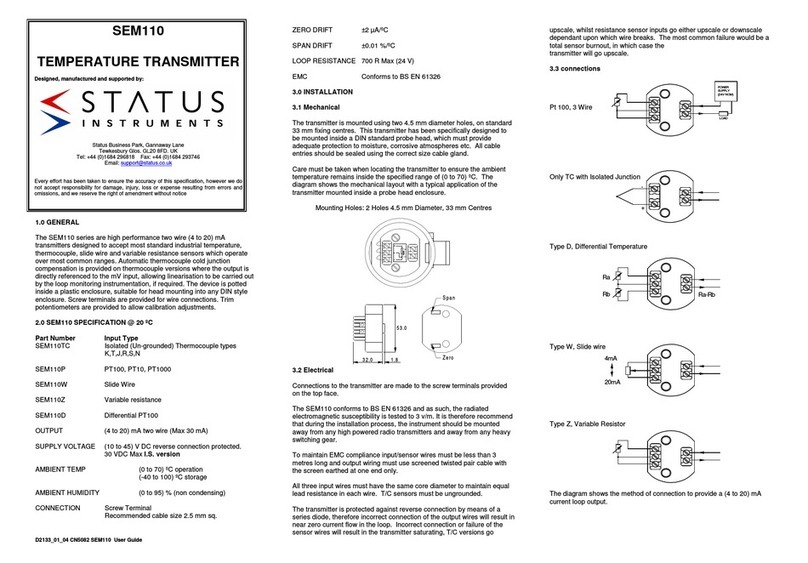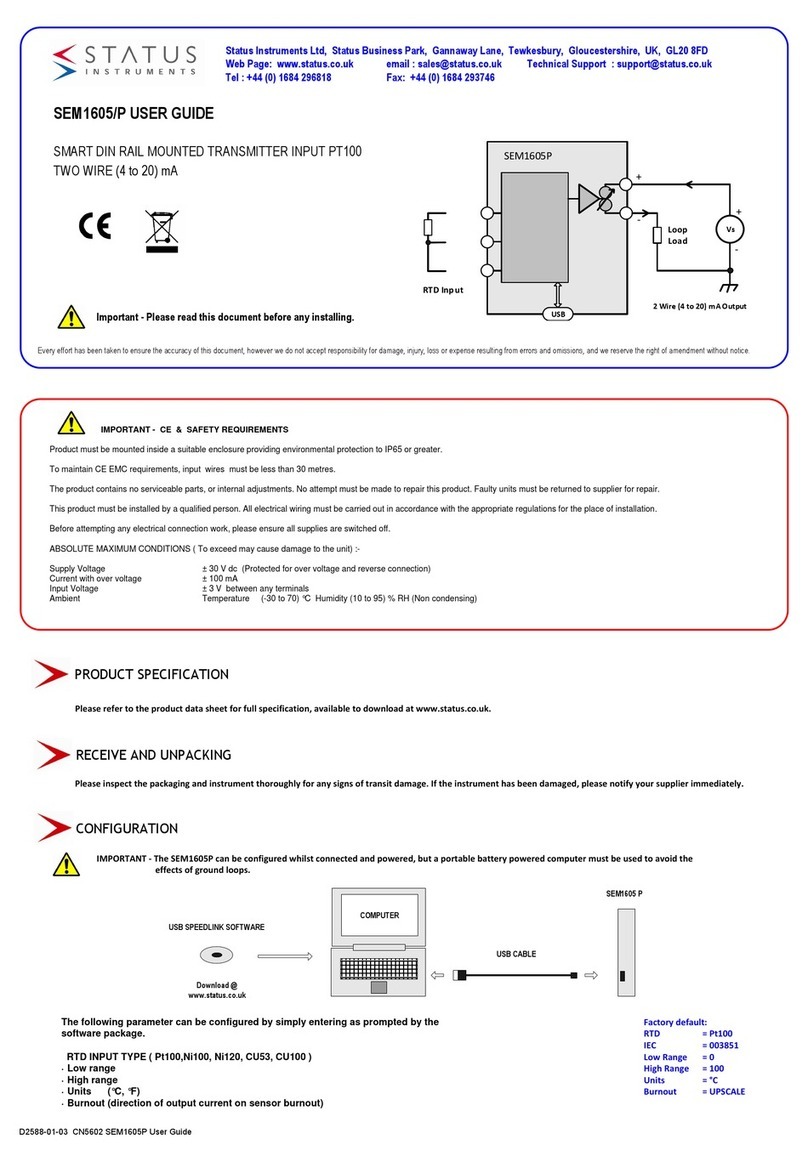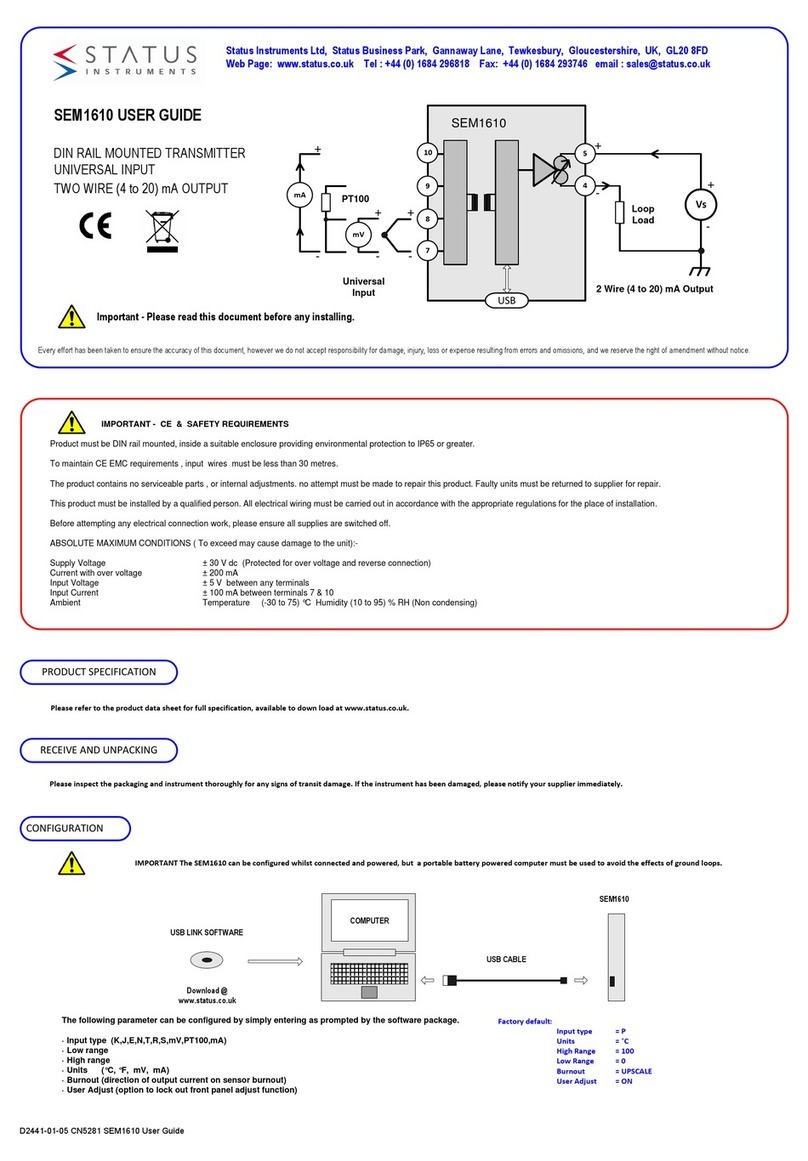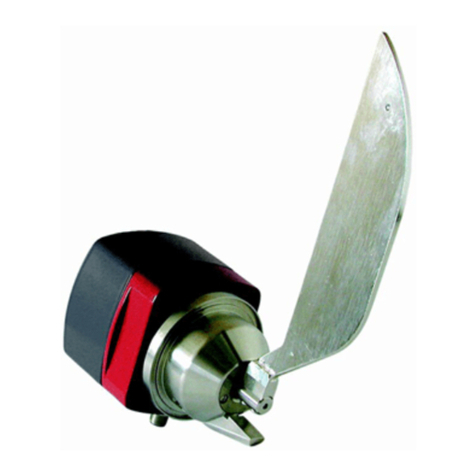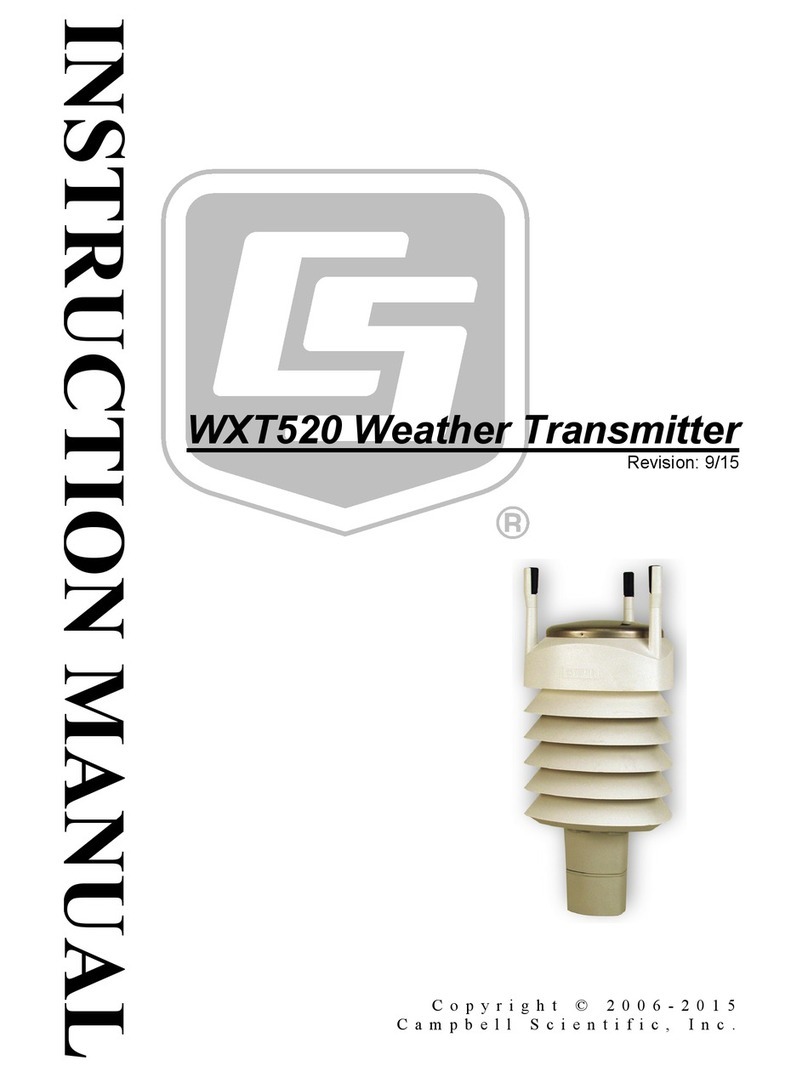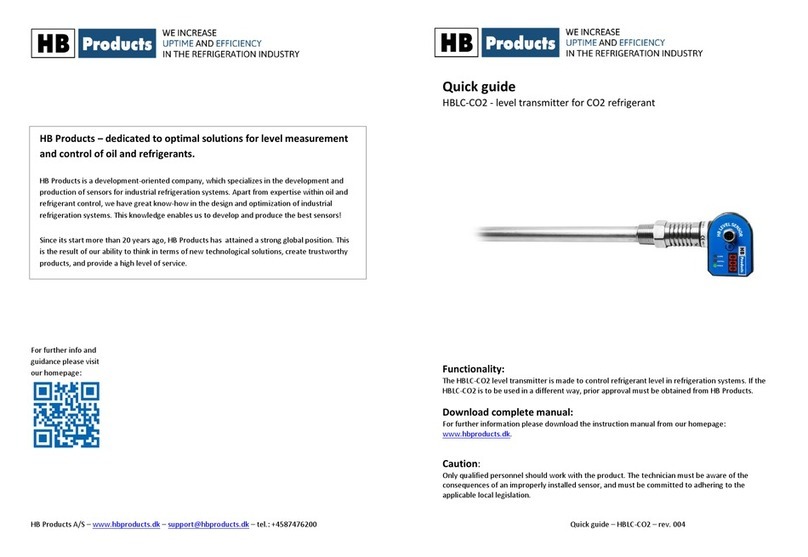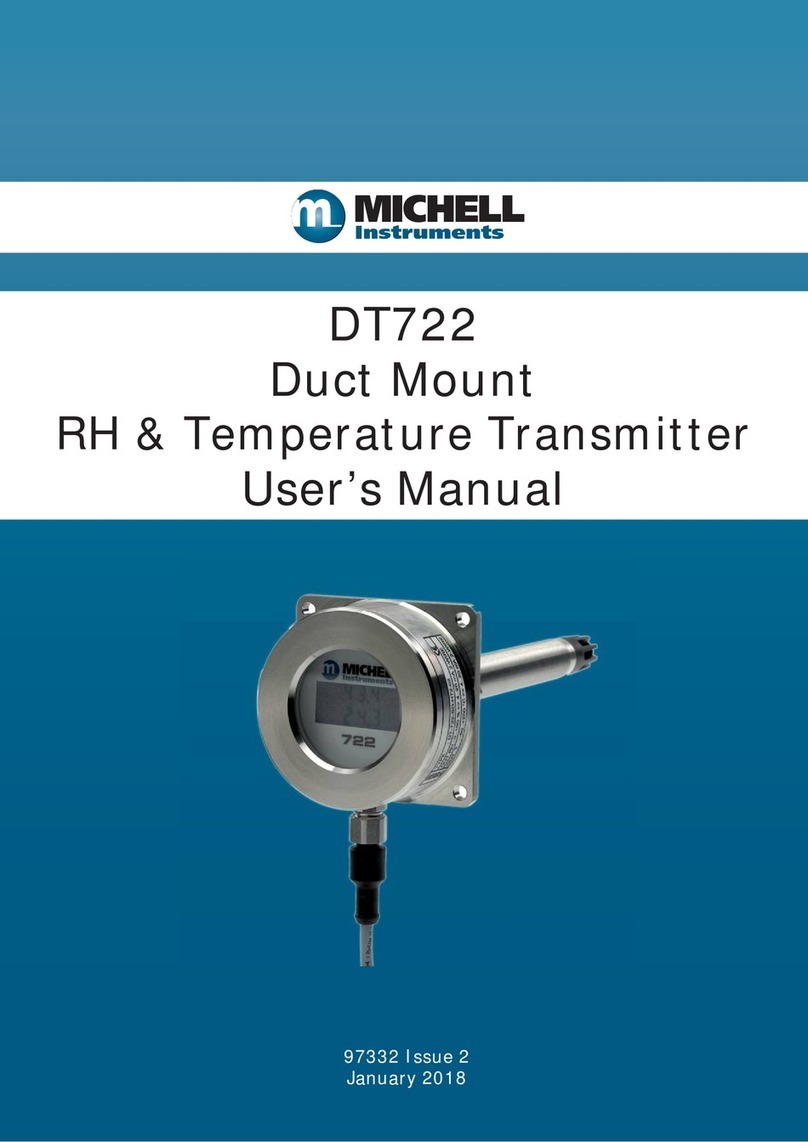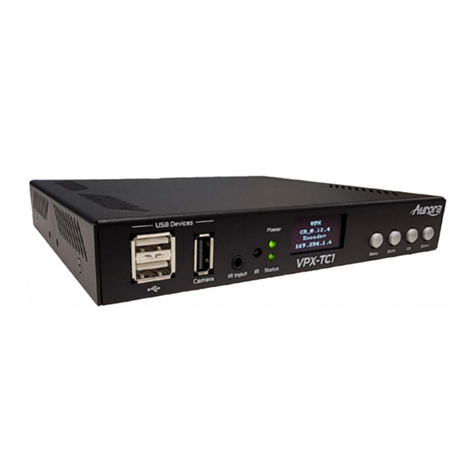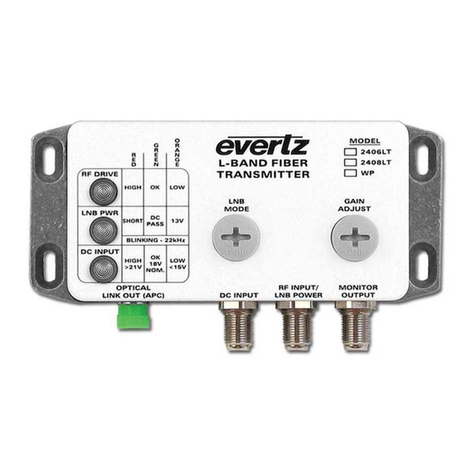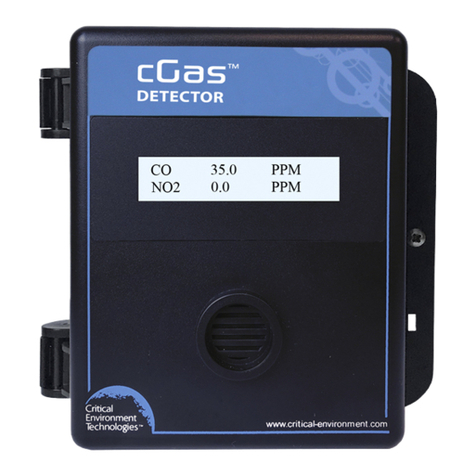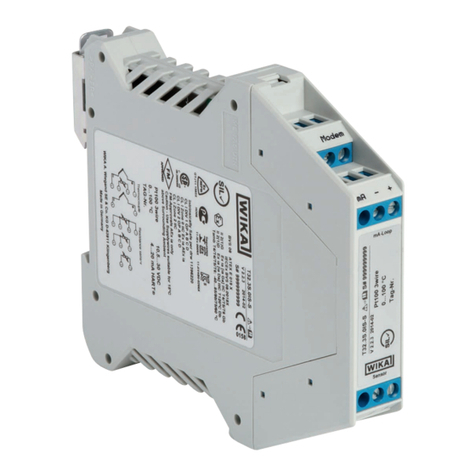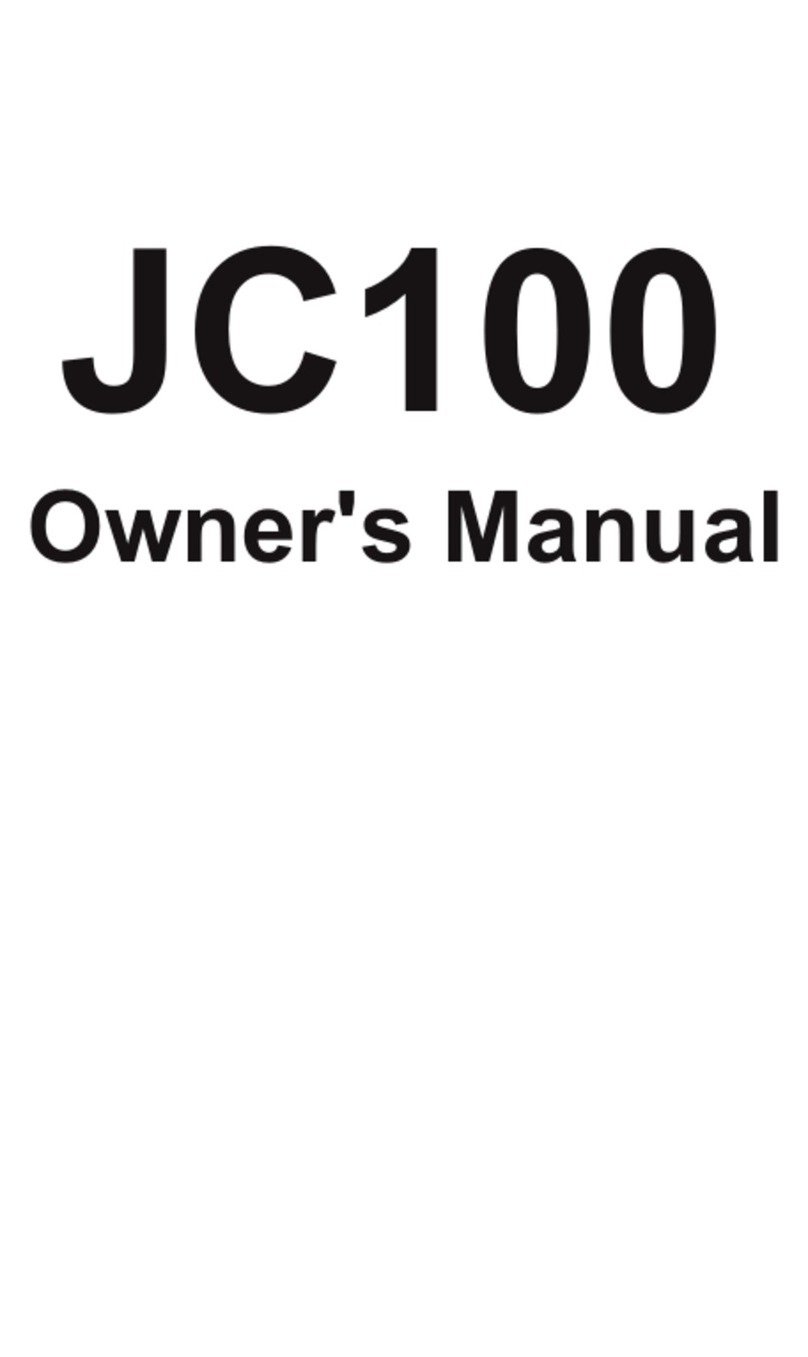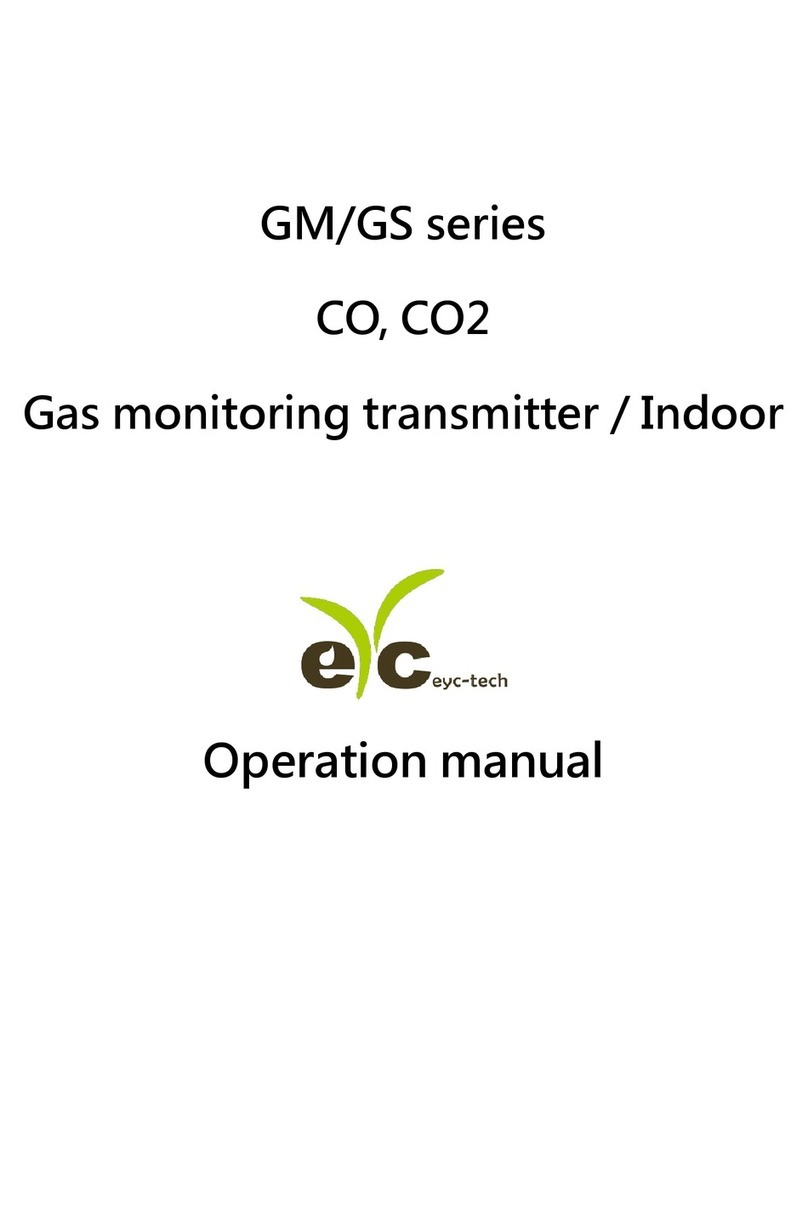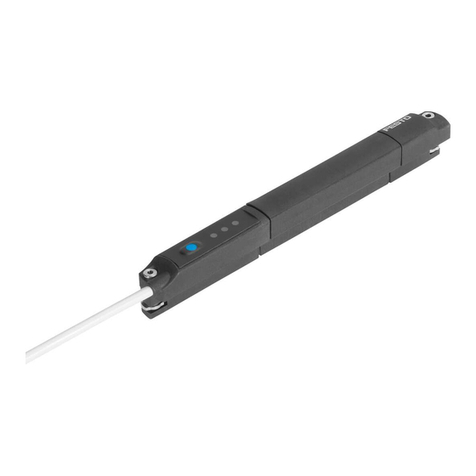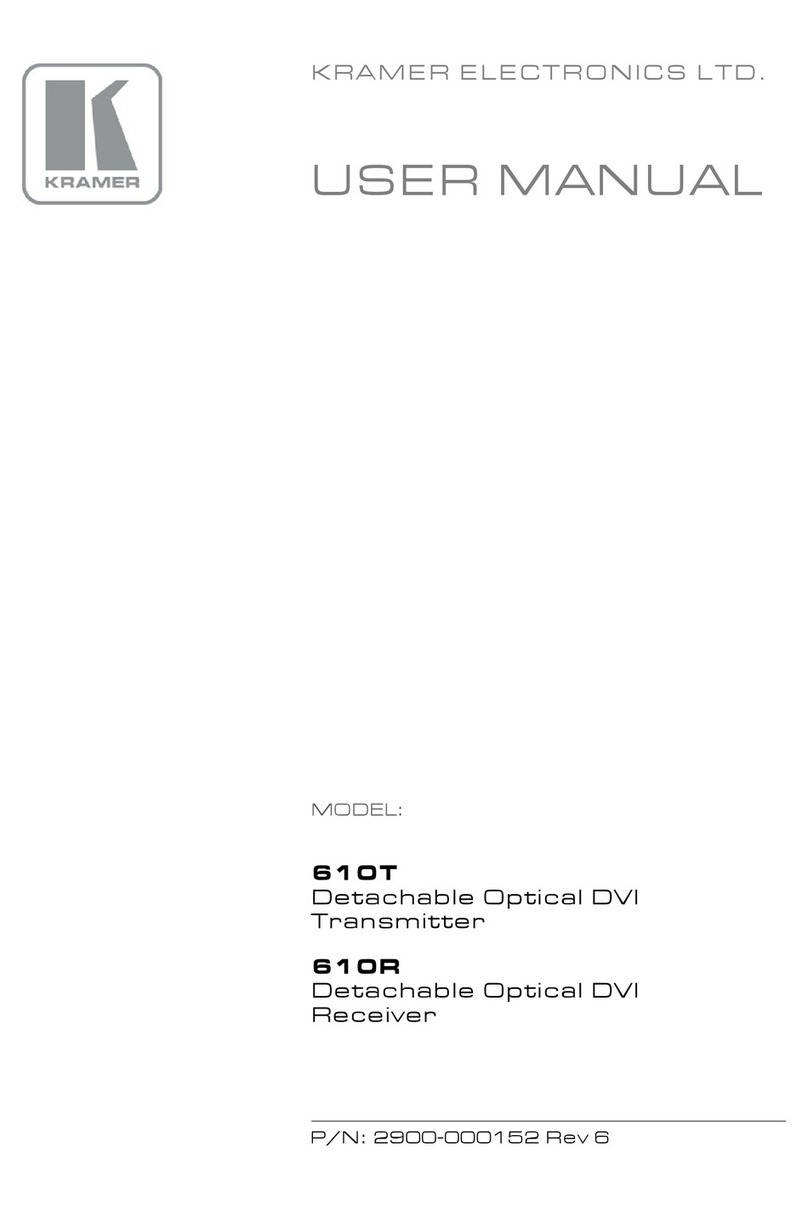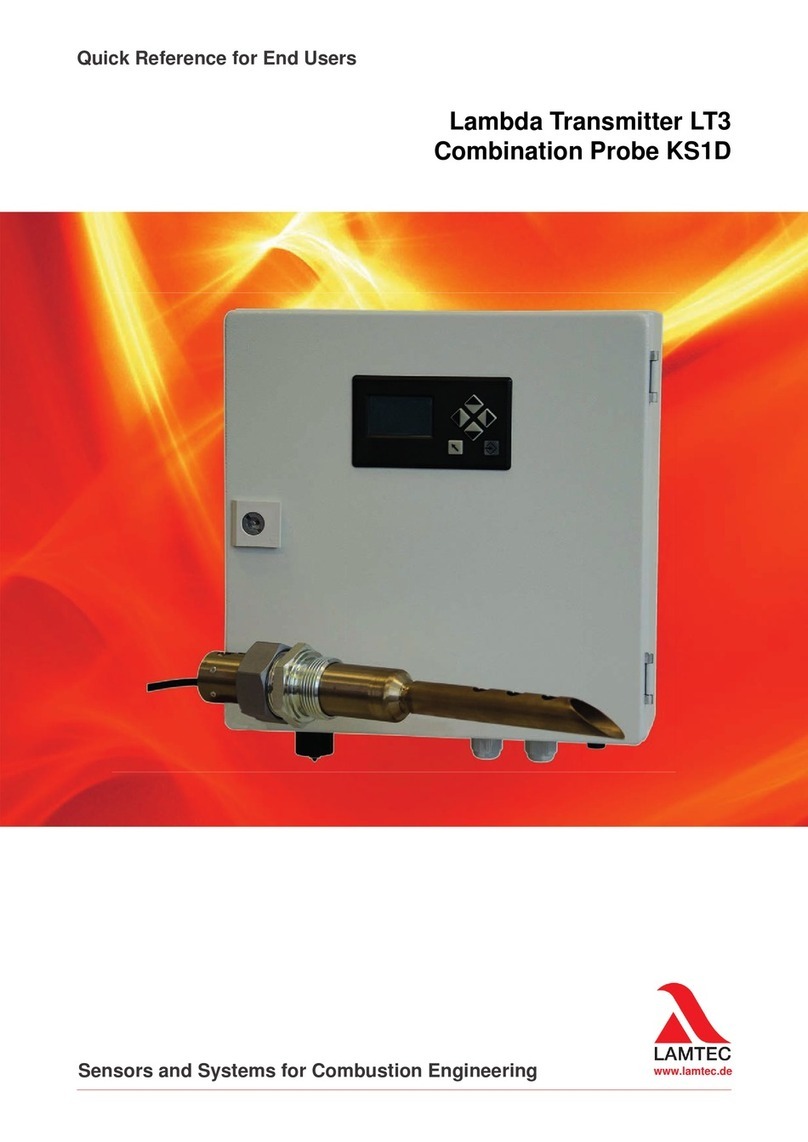Status Instruments SEM203P MKII User manual

MKII - Units with serial numbers above 112000
PUSH BUTTON PT100 TEMPERATURE TRANSMIT
TER
Mounting holes: 2 holes 0.22” (5.5mm) diameter, 1.3” (33mm) centers
Center hole sensor wire entry: 0.16” (4.0mm) diameter
Side View
1.69”
(43.0mm)
1.3”
(33.0mm)
Centers
0.83”
(21.0mm)
Base View
Figure 1
1.0 DESCRIPTION
The SEM203P MKII head mounted temperature transmitter connects to any standard pt100 resistance sensor and con-
verts the linearized temperature to a (4 to 20) mA signal. The transmitter is a two wire device, and is fully configurable
by the user, over a wide temperature range, with the aid of a simple push button. This new SEM203P MKII design
incorporates additional configuration menus, allowing the user to push button trim the transmitter output at both zero
and span, ideal for trimming out sensor errors and choose between upscale or downscale burnout (upscale is default).
The transmitters advanced circuitry guaranties high stability over the wide operating ambient temperature ranges
experienced by head mounted devices.
One of the transmitters features is the program LED, which provides visual indication of sensor fault when in normal
operation and is also used to guide the operator through the simple menus during configuration.
2.0 RECEIVING AND UNPACKING
Please inspect the packaging and instrument thoroughly for any signs
of transit damage. If the instrument has been damaged, please notify
your supplier immediately.
3.0 SPECIFICATION @ 68°F
INPUT
Sensor Type PT100 100
⍀
@ 0°C 2 or 3 Wire
Sensor Range (-328 to +1562)°F - (18 to 390)
⍀
Sensor Connection Screw terminal
Minimum Span (see Note 1) 40°F
Linearization
BS EN 60751 (IEC 751) standard /JISC 1604
Accuracy (see Note 2) ± 0.2°F ± 0.1% of Reading
Thermal Drift 0.005% / °F
Excitation Current <200 uA
Lead Resistance Effect 0.004°F /
⍀
Maximum Lead Resistance 20
⍀
per leg
Note 1 Any span may be selected, full accuracy is only guaranteed
for spans greater than the minimum recommended span.
Note 2 Basic measurement accuracy include the effects of calibration,
linearization and repeatability.
OUTPUT
Type Two wire (4 to 20) mA sink
Limits Low 3.8 mA; high 21.5 mA
Accuracy ± (mA out / 2000) or ± 5 uA which
ever is greater
Loop Effect ± 0.2 uA / V measured @ 50 Hz 1 V
(peak to peak)
Thermal Drift ± 0.06 uA / °F typical; ± 1.5 uA Max
Max Load [(V supply – 10) / 20] KΩ
GENERAL
Update Time 0.5 Seconds
Response Time 1 Second to reach 90% of final value
Start up time From power up typically 5 Seconds
Filter Factor Adaptive
Ambient Temperature (-40 to 185) °F
Connection Screw Terminal
Approvals BS EN 61326; 1998 – Electrical
equipment for measurement and
control ANNEX A; ANNEX F
Factory Default (0 to 100) °C upscale burnout
(0.0 °C user trim)
4.0 INSTALLATION AND WIRING
4.1 Mechanical
The SEM203P transmitter has been specifically designed to fit inside a DIN standard probe head
enclosure (such as the Status SCH-4 series), which provides adequate protection from moisture,
dust, corrosive atmosphere etc. All cable entries must be sealed using the correct size gland.
Likewise any probe assembly fitted must be sealed. Care must be taken when locating the transmitter
to ensure the working ambient temperature range of (-40 to 185°F) is not exceeded. The SEM203P
enclosure has a center hole allowing the sensor wires to enter screw terminals from the transmitter
center, this is applicable when the sensor is mounted directly below the transmitter.
4.2 Electrical
Electrical connections to the transmitter are made to the screw terminal provided on
the top face. The sensor wires must be equal length and type for the lead compensa-
tion to work correctly. The screw terminals allow for wires to enter either inner or outer
direction. The transmitter is protected against reverse connection and over voltage. If
no sensor (input) connection is made, the transmitter will go into either up or down
scale output current, depending on configuration.
Figure 2 gives connection details, the output is shown connected to a 24 V supply. The
load symbol represents any other device connected in the loop, such as monitoring
equipment, panel indicators and loop isolators. The load value can range from 0 ohms
to the max loop load for given supply, refer to section 3 “Max Load” for more informa-
tion. The transmitter conforms with EC directive BS EN 61326; 1998 when correctly
installed in a termination head providing at least IP20 protection and with sensor wires
less than 3 meters. Shielded or twisted pair wires are recommended for output wires.
Always ensure the (4 to 20 mA) loop is grounded at one point, this would normally be at
the monitoring equipment or loop power supply.
In normal operation the program LED acts as over-range LED.
Figure 2
WHITE
Load
POWER
SUPPLY
Pt 100
RED
RED
OPERATING SPECIFICATIONS
SEM203P MKII
When using a 2-wire RTD put a jumper across terminals connected to red wires in Figure 2.

Figure 3
POWER
SUPPLY
(10-30) VDC
PROGRAM
BUTTON
4-20 mA
CURRENT METER
(OPTIONAL)
CALIBRATOR
RTD
BURNOUT/
PROGRAM LED
Menu 3 User Trim (Timeout is 20 Seconds)
This menu allows the user to trim the output current at 4 mA and 20 mA points,
(similar function to trim potentiometers) and is very useful for trimming out
sensor errors.
The input of the transmitter must be connected to either a calibrator or a tem-
perature sensor held at a known temperature. The (4 to 20) mA loop current
will also need to be monitored with a current meter.
Refer to Figure 3. Connect sensor or resistance box to SEM203P input terminals using three
wire connection. Connect output to a DC supply, observe polarity, connect current meter in
series with loop. Turn power on and allow 1 minute warm up period.
Set calibrator to the equivalent resistance of the pt100 sensor, at required trim point.
Alternatively ensure sensor temperature is at the required calibration point.
The transmitter will automatically trim the 4 mA end if the output is within the active band of
(3.8 to 6) mA, and trim the 20 mA end if the output is within the active band of (18 to 21.5) mA.
No setting adjustment is performed if the output current is not within these two bands. Ensure
your calibration points are within these bands.
Press and hold button > 2 seconds to enter menus, menu 1 will then be selected, indicated by
one flash every burst.
Single press button to advance election to menu 2, and single press again to select menu 3
indicated by three flashes of the program LED every burst.
While menu 3 is selected, press and hold button > 2 seconds to enter menu 3, at which stage
the program LED toggle on and off at either a slow rate indicating downward trim direction or
fast rate indicating upwards trim direction.
To change trim direction double press button. The Program LED toggle rate will toggle to the
opposite direction. Repeated double presses will toggle between up and down trim direction.
To trim output current, single press button to advance current 2 uA in set direction, or press and
hold button to auto advance in set direction. Note, after approximately 20 seconds of continuous
button press, the auto trim rate will speed up. Monitor the current change on the current meter.
To store new setting allow 20 seconds with no button action, the program will then timeout,
store new setting then return to normal operation.
Reset to Factory Default Settings
If required, the SEM203P can be reset to factory default setting, this procedure also
removes any user trim adjustment. Factory default settings are:
Range (0 to 100)°C
Burnout Up-scale
User Trim All user adjustment cleared
To reset to factory settings, hold the button down while the SEM203P is powering up.
Using Menus
Menu 1 Range Configuration (No Timeout)
Configuration will require the following tools and equipment:
• DC Supply (12 to 30) V @ 30 mA
• Precision resistance decade box to simulate PT100 sensor.
• Screw driver flat blade 3 mm wide
• PT100 resistance tables
• Current meter (user trim)
To re-range the temperature scale follow the following instructions:
Refer to Figure 3, connect resistance box to SEM203P input terminals
using three wire connection. Connect output to a DC supply, observe
polarity. Turn power on and allow 1 minute warm up period.
Set calibrator to the equivalent resistance of the pt100 sensor, at required
low range temperature. If the program LED is on at this stage the input is
out of range, check resistance and connection.
Press and hold button > 2 seconds to enter menus, menu 1 will then be
selected, indicated by one flash every burst.
While menu 1 is selected, press and hold button > 2 seconds to enter menu
1, at which stage the program LED toggle on and off at a slow rate.
Allow ten seconds then single press button to store low range setting, the program LED will
now flash at a fast rate.
Set calibrator to the equivalent resistance of the pt100 sensor, at required high range temper-
ature and allow ten seconds.
Press button to store high range setting, the program LED will flicker for one second before
the transmitter returns to normal operation. The transmitter is now re-ranged.
Menu 2 Burnout Selection (Timeout is 3 Seconds)
Refer to Figure 3. Connect output to a DC supply, observe polarity. For this menu the input can
be connected or open circuit. Turn power on.
Press and hold button > 2 seconds to enter menus, menu 1 will then be selected, indicated by
one flash every burst.
Single press button to advance selection to menu 2, indicated by two flashes of the program
LED every burst.
While menu 2 is selected, press and hold button > 2 seconds to enter menu 2, at which stage
the program LED will either toggle on and off at a slow indicating low scale burnout or fast rate
indicating upscale burnout.
To change burnout direction single press button. The Program LED toggle rate will change to
the other setting. Repeated single presses will toggle between up and down scale.
To store setting allow 3 seconds with no button action, the program will then timeout, store
new setting then return to normal operation.
User Configuration
User configuration uses three menus, each menu sets a different parameter:
Menu 1 Set range
Menu 2 Set direction of output on sensor burnout
Menu 3 User trim at 4 mA and 20 mA
The configuration menus are navigated using the push button and program
LED. The push button is located under the hole in the keyhole shaped wiring
label. To press the button use a 3 mm screw driver (flat blade) inserted into the
hole. The button has a slight click action.
Three types of button press are used:
• Single button press = Advance
• Double press within 0.5 seconds = Escape or change direction
• Press and hold button > two seconds = Enter
When a menu is selected the Program LED will flash in bursts of one to three
flashes, the number of flashes represents the menu number.
Navigating the menus
To access menus, press and hold button > 2 seconds, then program LED will
start to flash, one flash every burst. This indicates “menu 1” is selected.
Use single button press to advance selection to “menu 2”, the program LED
will now show two flashes per burst. The next single press will advance the
selected menu to menu 3 and the next single press will advance selected
menu back to menu 1. Repeated single presses will cycle the selected
menu back around menus 1 to 3, in the above sequence.
Double press button to escape from menus, and return to normal. Normal
operation can also be selected by turning transmitter power off and on.
Note the transmitter will not time out and automatically escape from menus.
IMPORTANT
READ COMPLETE SECTION BEFORE ATTEMPTING CONFIGURATION
PARTICULAR CARE SHOULD BE TAKEN REGARDING TIMEOUTS IN MENU 2 & 3
5.0 USER CONFIGURATION
•
•
•
•
•
•
•
•
•
•
•
•
•
•
•
•
•
•
•
•
•
•
•
•
•
Every effort has been taken to ensure the accuracy of this specification, however we do
not accept responsibility for damage, injury, loss or expense resulting from errors and
omissions, and we reserve the right of amendment without notice.
PO Box 548, 456 Park Ave.,
Scotch Plains, NJ 07076
P: (908) 490-0232 P: (800) 700-3272
F: (800) 700-5468 E: bm@statinst.com
www.statinst.com
Other Status Instruments Transmitter manuals
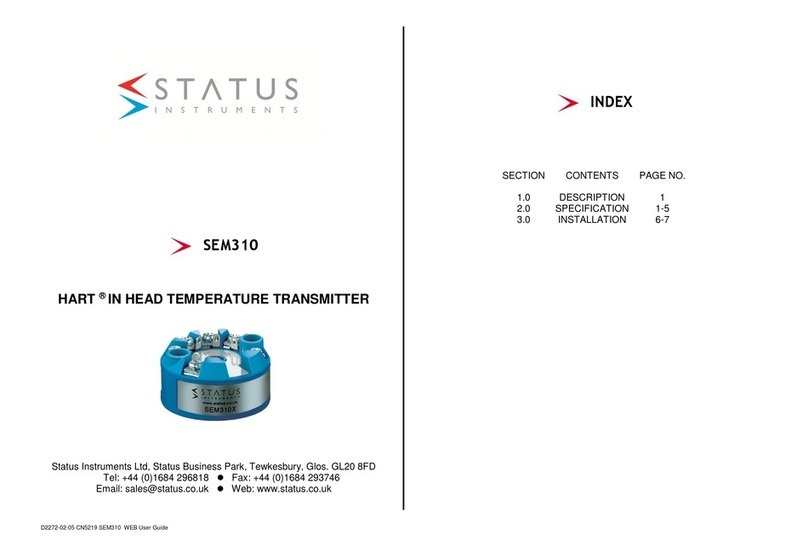
Status Instruments
Status Instruments SEM310 User manual
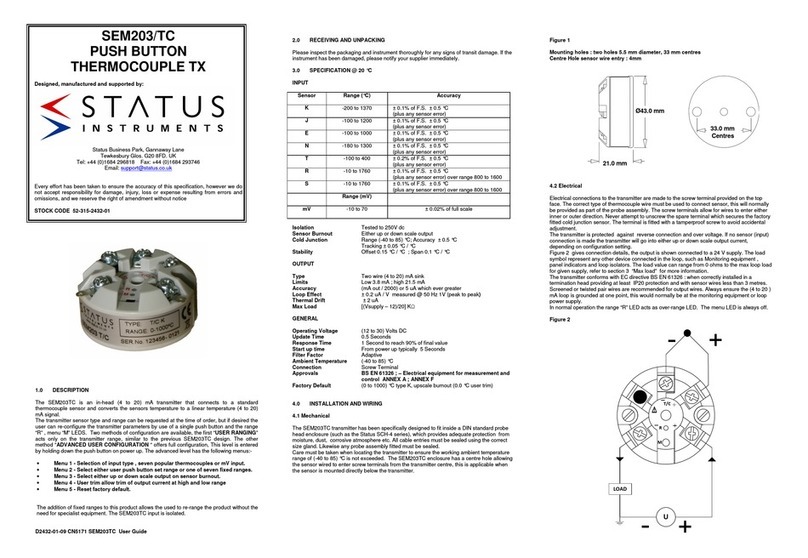
Status Instruments
Status Instruments SEM203/TC User manual
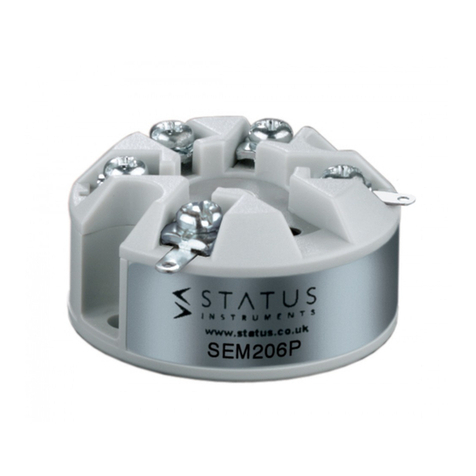
Status Instruments
Status Instruments SEM206/P User manual
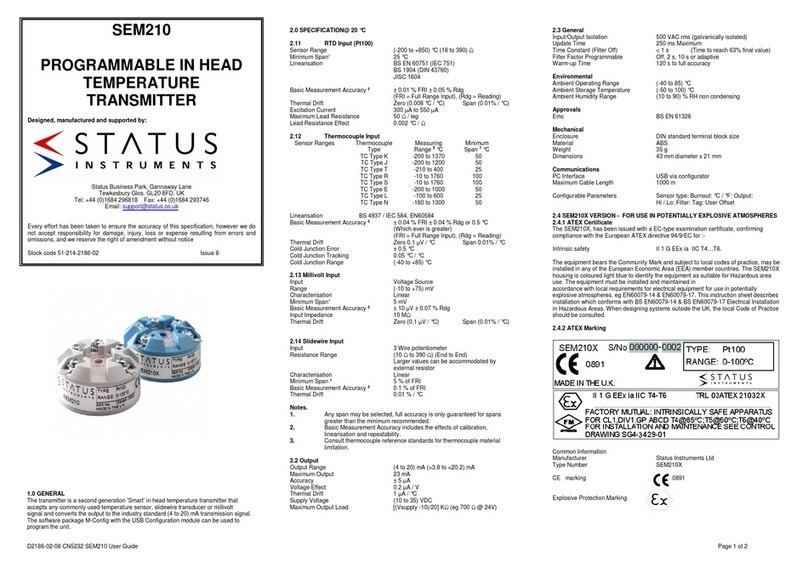
Status Instruments
Status Instruments SEM210 User manual

Status Instruments
Status Instruments SEM1603TC User manual
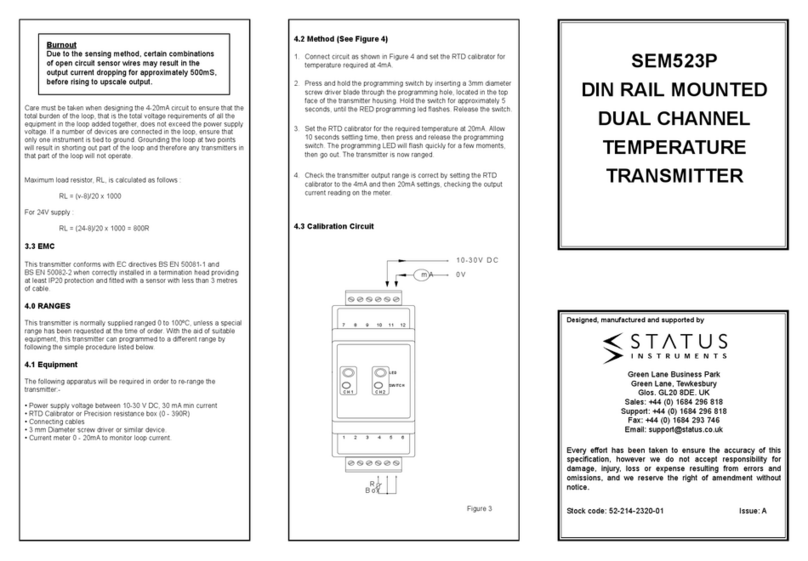
Status Instruments
Status Instruments SEM523P User manual
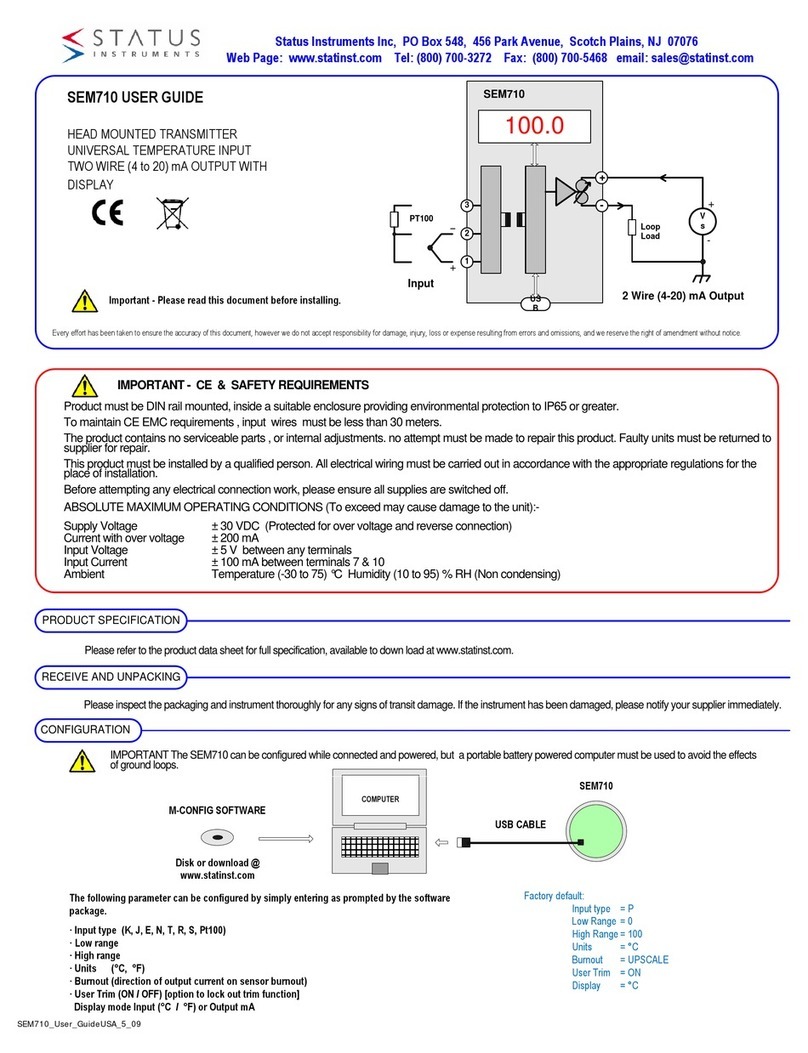
Status Instruments
Status Instruments SEM710 User manual
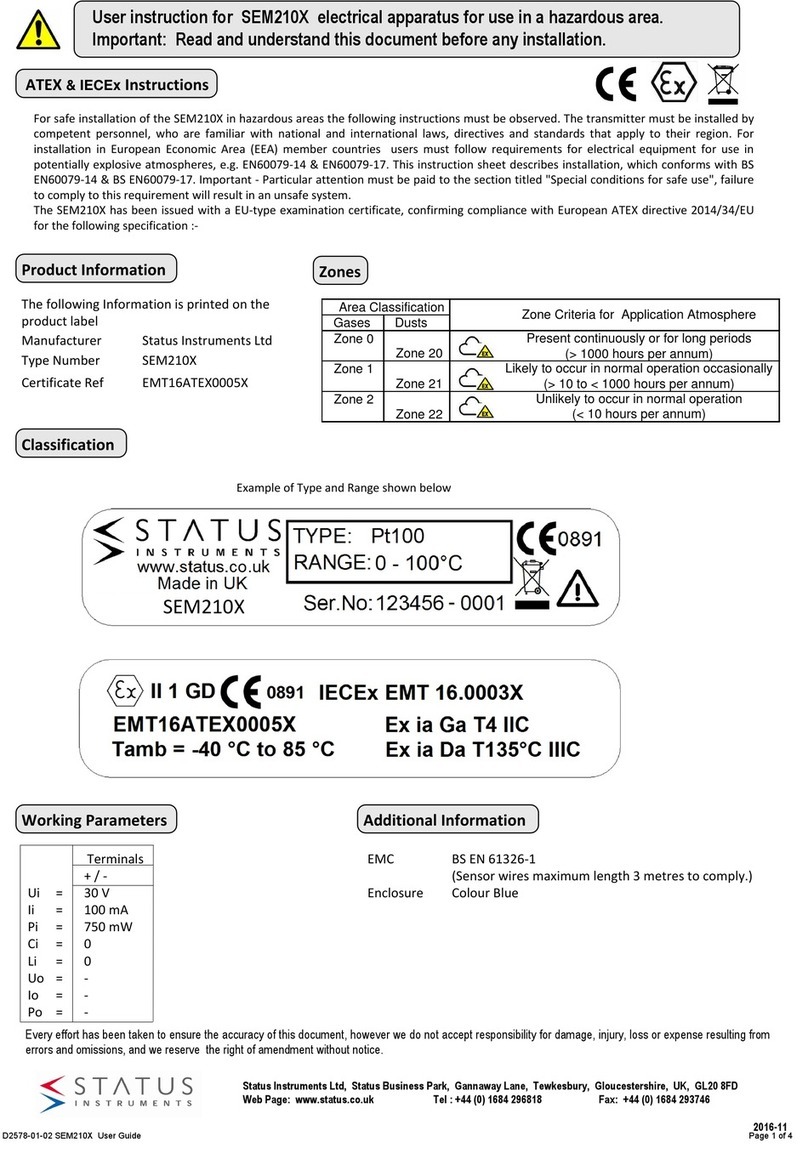
Status Instruments
Status Instruments SEM210X Installation instructions
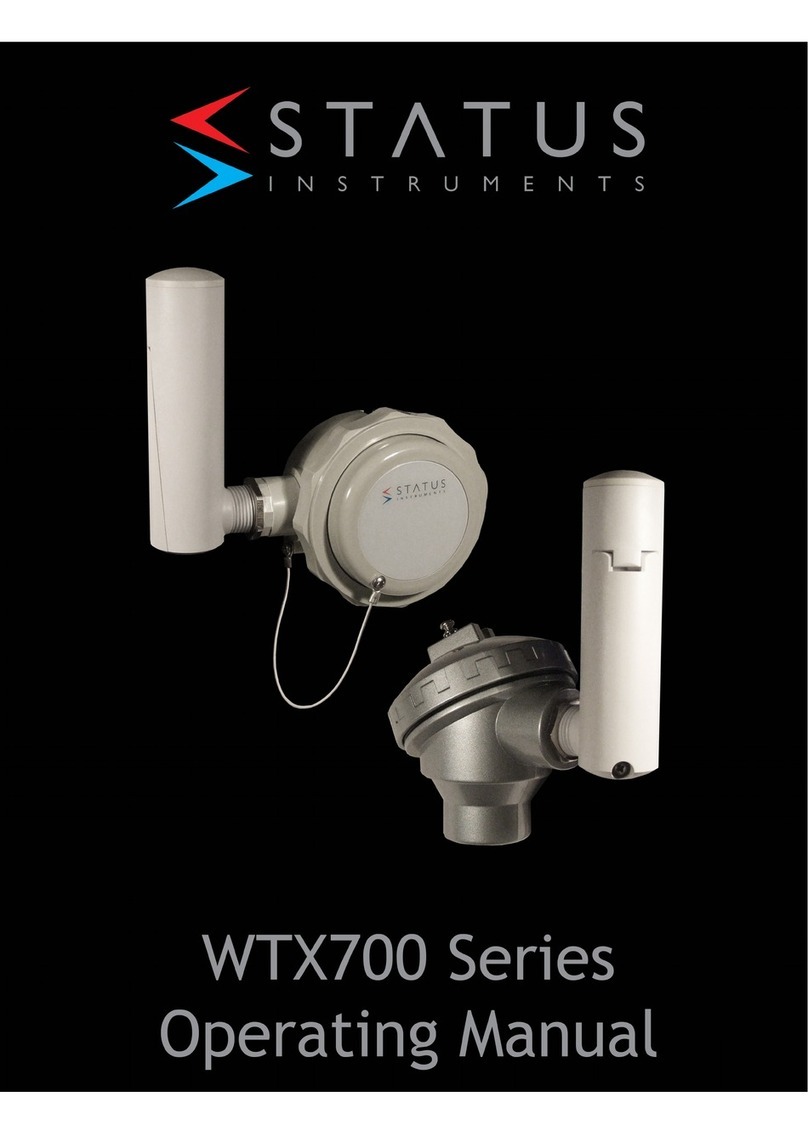
Status Instruments
Status Instruments WTX700 Series User manual

Status Instruments
Status Instruments SEM310 User manual
